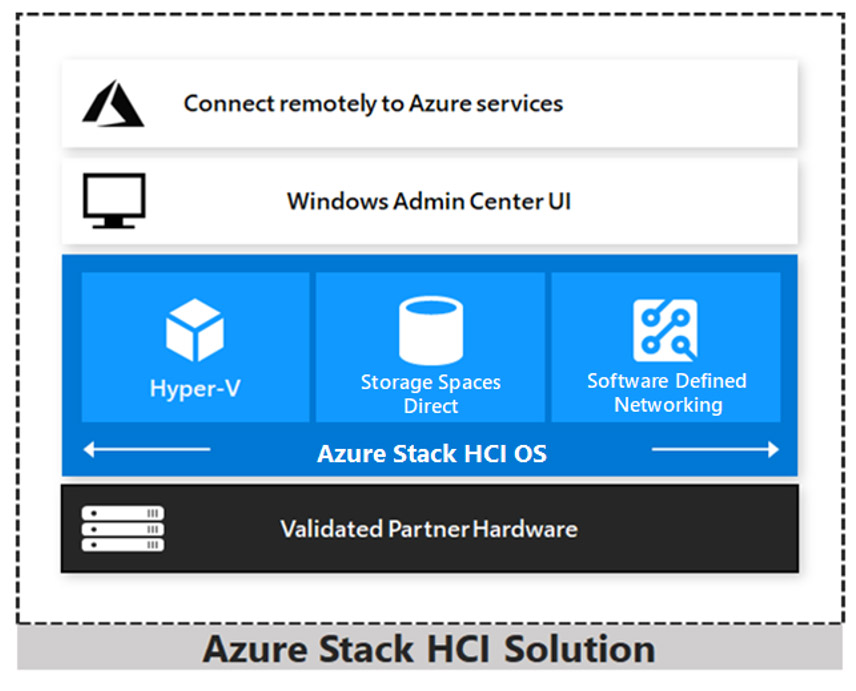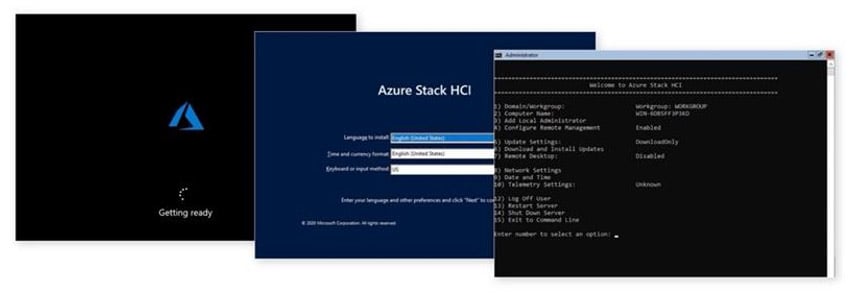At the all-digital Inspire event on 22&23 July, Microsoft introduced a new release for Azure Stack HCI, Microsoft’s hyperconverged solution for deploying infrastructure on-premises. The most prominent change this release brings is an operating system release designed specifically for Azure Stack HCI, instead of leveraging Windows Server 2019 directly.
Here’s a look at the Azure Stack HCI architecture – it integrates with and relies on Microsoft Azure for licensing purposes, but it’s built on and managed with Windows Admin Centre on top of validated hardware configurations:

This new release of the Azure Stack HCI solution currently in preview, includes several new features:
Clusters running Azure Stack HCI, version 20H2 have the following new features as compared to Windows Server 2019-based solutions:
- New capabilities in Windows Admin Center: With the ability to create and update hyperconverged clusters via an intuitive UI, Azure Stack HCI is easier than ever to use
- Stretched clusters for automatic failover: Multi-site clustering with Storage Replica replication and automatic VM failover provides native disaster recovery and business continuity to clusters that use Storage Spaces Direct
- Affinity and anti-affinity rules: These can be used similarly to how Azure uses Availability Zones to keep VMs and storage together or apart in clusters with multiple fault domains, such as stretched clusters
- Azure portal integration: The Azure portal experience for Azure Stack HCI is designed to view all your Azure Stack HCI clusters across the globe, with new features in development
- GPU acceleration for high-performance workloads: AI/ML applications can benefit from boosting performance with GPUs
- BitLocker encryption: You can now use BitLocker to encrypt the contents of data volumes on Azure Stack HCI, helping government and other customers stay compliant with standards such as FIPS 140-2 and HIPAA
- Improved Storage Spaces Direct volume repair speed: Repair volumes quickly and seamlessly
Along with the hardware solutions available from OEMs which can start with a 2-node deployment and a cheaper price point (particularly when compare to Azure Stack Hub), Azure Stack HCI looks to have a number of advantages going for it:
- While Windows Server Hyper-V isn’t going anywhere soon, System Centre Virtual Machine Manager is still complex to deploy and manage. At a similar price point and hardware configuration (CPU, RAM, storage etc.) to legacy Microsoft-based virtualisation solutions, Azure Stack HCI’s integration with Microsoft Azure places it into affordable territory for hybrid-cloud deployments. With a simplified architecture, Azure Stack HCI OS could easily become the preferred Microsoft approach to on-premises virtualisation

Azure Stack HCI operating system
- Microsoft specifically talks to virtual desktop infrastructure (VDI) as a use-case for Azure Stack HCI. I believe it’s logical to conclude that Azure Stack HCI could be the method through which Microsoft will bring Windows Virtual Desktop (WVD) deployments on-premises for the SMB market. WVD has garnered a lot of interest as a desktop virtualisation solution, but it is currently an Azure only service – allowing WVD deployments into existing data centres will provide customers the flexibility they often require
- Assuming Citrix will provide support for it, Azure Stack HCI will simplify the architecture for hybrid Citrix Cloud deployments by removing the need to manage on-premises Microsoft virtualisation hosts with System Centre Virtual Machine Manager. While Citrix doesn’t yet support clusters managed with Windows Admin Centre, the continued improvement in that product and any success that Microsoft has with Azure Stack HCI, will help to encourage customer demand for simplified Citrix virtualisation support
Microsoft certainly has a lot of competition in this space, but I am hopeful that Azure Stack HCI presents a new opportunity to leverage their success in Azure to provide organisations with a simpler on-premises virtualisation solution for those customers looking to succeed in a hybrid cloud deployment.











